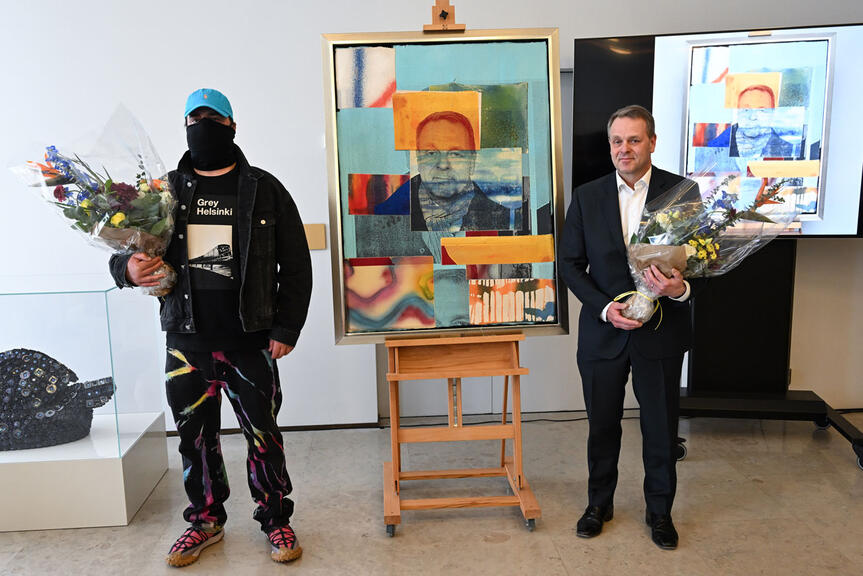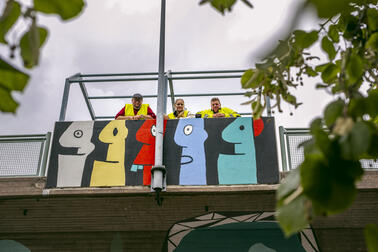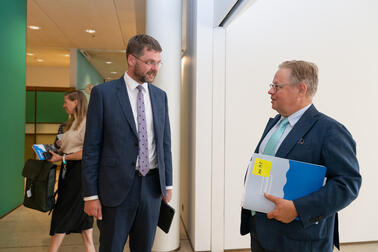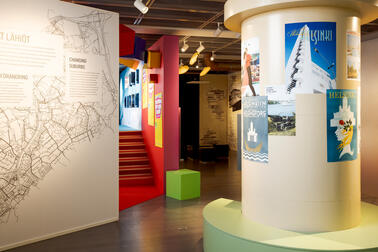
A portrait of former mayor Jan Vapaavuori was unveiled at Helsinki City Hall on Thursday. The portrait’s artist EGS said the concept of “layers of the city” served as the inspiration for the piece. Both cities and people grow upwards as the years go by, and both build up layers as the future eclipses the past. The creative process behind the portrait consisted of many stages, which were captured in a video. The video can be accessed with the QR code that is a part of the finished artwork. The 119 cm-high and 89 cm-wide portrait is an aggregate of photos and painted swathes of canvas assembled in layers.
“Most of the portrait isn’t visible. I painted several canvases during the process, each with images and other references to Helsinki, the city where Vapaavuori has lived and worked. They also contained elements of the Helsinki of the future that the former mayor has envisioned. As is the case with many projects, most of the work that went into it remains hidden. The same could likely be said for Vapaavuori’s work as mayor: only part of it can be seen today. Perhaps some things won’t be revealed until several years from now, while others will remain unseen. Each of us also has our own private and secret layers. Not everything is open to the public,” EGS said.
Art historian Tomi Moisio was able to view the portrait before the unveiling.
“It is a layered portrait in a literal sense, as it is composed of 11 separate canvases. The layers aren’t hierarchical; they are meant to reveal varying aspects of the subject at hand. The collage-like whole provides us with concurrent glimpses of the public and private, the shared and the personal. Although it is officially a portrait of the mayor, Helsinki is also the protagonist in the same way.
Only a small fraction of the layers of a city are consciously added to the mix. A larger proportion is created organically each year by the city’s residents and visitors. Manifestations of history and culture leave traces in the cityscape that cannot be undone by any one person. Layers of buildings representing different eras lead to parallel and partly overlapping strata of meaning.
The city is a kind of palimpsest, a meaningful text under which previous texts and meanings can be heard. Some of these meanings have been deliberately erased, but even then, the new text still carries traces of these earlier meanings. EGS's background in graffiti provides an interesting context for the “layers of the city” we see in this work. Graffiti is also a palimpsest of sorts because new works are often painted over old ones. The base of the painting also forms its own, very meaningful layer,” Moisio commented.
Status of graphic arts in urban culture strengthened during Vapaavuori’s term
The City of Helsinki’s role in relation to graffiti culture has varied. From 1998 to 2008, a campaign to stamp out graffiti was carried out, giving rise to intense public criticism.
During the time that Jan Vapaavuori was mayor, however, graffiti art found its way into the mayor’s office itself, and soon areas where graffiti could be practiced freely were popping up in different parts of the city.
“During my mayoral term, I passionately sought to renew and modernise Helsinki. I was driven to do this by my wide-ranging fascination with the city and the many dimensions of its urban life. For me, Helsinki is first and foremost a place and community that is always on the move. I wanted my portrait to be rooted in the present, but at the same time, to call attention to Helsinki’s many layers. EGS and I are united by a love for Helsinki, as well as an affinity for cities in general, urban cultures, and life’s rough edges. The creative process leading up to the portrait’s completion became quite personal for me; with the artist’s guidance, it was ultimately more profound than I could have imagined. This connection perhaps resulted in a new interpretation of the traditional portrait, but it also gave rise to a high-quality work of art that I feel beautifully complements the other portraits of City of Helsinki leaders in the series,” Vapaavuori said.
The current Helsinki Mayor Juhana Vartiainen believes that his predecessor paved the way as Helsinki’s first elected mayor in showing how the new system of city management would work and what kinds of structures would steer the city’s development.
“Under Jan Vapaavuori's leadership, Helsinki became an even more international metropolis and global trendsetter. Our role in mitigating climate change in cities is a good example. Janne has above all been a staunch defender of issues that matter to Helsinki and its residents. His stamp on the development of the city will definitely live on,” said Mayor Vartiainen.
Background information on the artist known as EGS
Born in 1974, the artist who works anonymously under the name of EGS is one of Finland’s most internationally recognised and highly networked graffiti artists. During his approximately 30-year career, the artist has worked in over 50 countries. In recent years EGS has blurred the line between street art and gallery art and expanded his work into sculpture and blown glass. Over time, the artists’ work has moved from the urban environment into galleries and museums around the world.
A piece from EGS named “The Archipelago of Yesterday and Tomorrow” was on display on Vallisaari Island during the inaugural Helsinki Biennial art event, hosted by the Helsinki Art Museum HAM. An EGS painting that was featured in the Biennial was transferred to Vapaavuori’s office during his term as mayor.
EGS – CV & About,
egshelsinki.com(Link leads to external service)
Background information on the City of Helsinki’s portrait tradition
The tradition of commissioning portraits of mayors, city managers and City Council chairs in Helsinki stretches back to the end of the eighteenth century. The oldest work in the portrait collection is Nils Schillmark's painting of former city manager Anders Byström from 1780. The most famous portrait in the collection is Albert Edelfelt's 1901 painting of Leo Mechelin, who served as the chair of Helsinki's first City Council.


